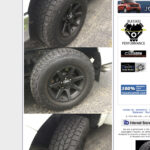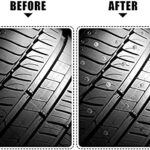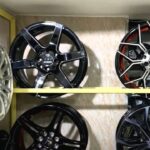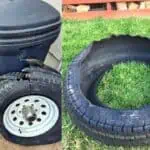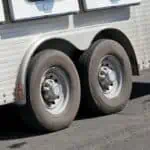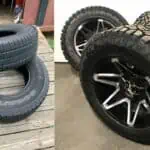You may have seen it before while driving on the highway – a trailer with two different size tires. While this may not seem like a big deal, it is actually a very serious safety hazard. Two different size tires on a trailer can cause the trailer to veer off to one side, making it difficult to control.
This can lead to accidents and even injuries. If you see a trailer with two different size tires, be sure to report it to the authorities so that they can take action.
If you have ever looked at a trailer and wondered why one of the tires is always significantly larger than the other, you are not alone. It’s a common question, and there is actually a very good reason for it.
The larger tire on a trailer is called the “stabilizer.”
Its purpose is to help keep the trailer from rocking back and forth when you are driving down the road. The stabilizer also helps to keep the load on the trailer more evenly distributed, which can help prevent problems with tire blowouts.
So if you are ever wondering why one of your trailer tires looks a lot bigger than the other, now you know!
The stabilizer tire is there to help keep your trailer safe on the road.
Tech Tips with Mike T – Trailers Part 2: Tires
Can You Mix Trailer Tire Sizes?
No, you cannot mix trailer tire sizes. All four tires on a trailer must be the same size and have the same load rating. Mixing tire sizes can lead to uneven wear and decreased stability, which is dangerous when hauling a heavy load.
If you need to replace one or more tires on your trailer, be sure to get the same size and load rating as the existing tires.
Do Trailer Tires Need to Match?
It’s not necessary for trailer tires to match, but it is recommended. Having two different types of tires on a trailer can create uneven wear and tear, which can lead to problems down the road. If you do have two different types of tires on your trailer, be sure to check the air pressure and tread regularly to prevent any issues.
What Happens If You Have Two Different Size Tires?
If you have two different size tires, the smaller tire will rotate faster than the larger tire. This can cause problems with your drivetrain, and may eventually lead to damage to your transmission or differential. It’s generally not recommended to drive with two different size tires.
Can You Mix And Match Trailer Tires?
While it is possible to mix and match trailer tires, it is generally not recommended. This is because different tires can have different load capacities and tread patterns, which can lead to uneven wear and tear on the tires. Additionally, mismatched tires can cause handling issues with your trailer.
For these reasons, it is usually best to use tires that are the same size, load capacity, and tread pattern.
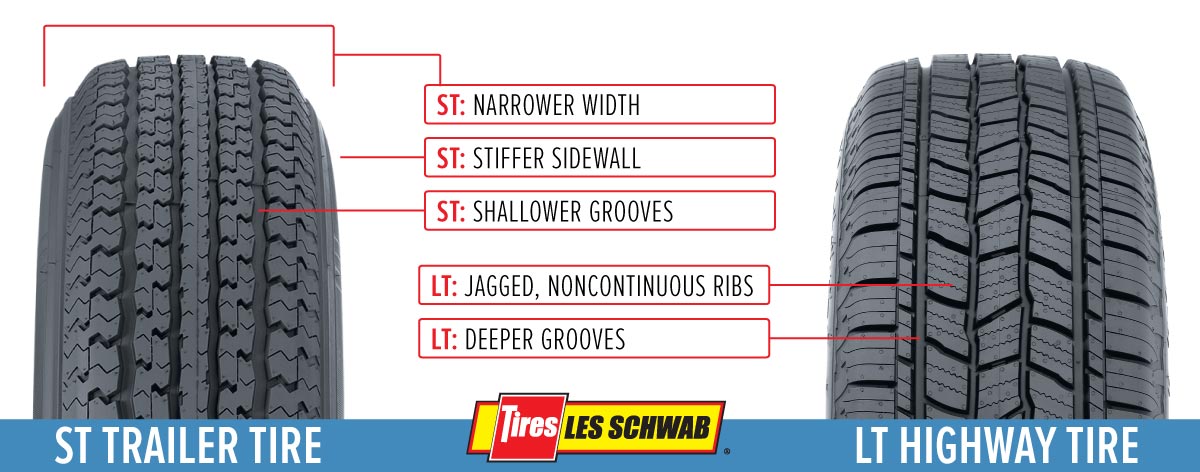
Credit: www.lesschwab.com
Trailer Tires
One of the most important parts of towing a trailer is making sure that the tires are in good condition. Trailer tires are different than regular passenger vehicle tires in a few ways. They are designed for towing and hauling heavy loads, so they need to be strong and durable.
They also need to be able to grip the road well, even when going around tight corners or making sudden stops.
When shopping for new trailer tires, it’s important to pay attention to the load rating. This is how much weight each tire can safely carry.
You’ll also want to look at the speed rating, which tells you how fast the tire can go before it starts to wear out too quickly. Most trailer tires have a load rating of 80 or 90, and a speed rating of 65 or 70.
It’s also a good idea to get your trailer tires balanced and aligned by a professional before hitting the road.
This will help them last longer and prevent premature wear. And finally, make sure you check your trailer tires regularly for any signs of damage or wear and tear. If you take care of your trailer tires, they’ll take care of you out on the open road!
Are Bigger Tires Better for Trailers
Whether you are towing a trailer for work or play, the question of what size tires to use is an important one. There are many factors to consider when making this decision, including the type and size of your trailer, the weight of your load, and the terrain you’ll be traversing. So, are bigger tires better for trailers?
Let’s take a closer look.
The first factor to consider is the type of trailer you have. If you have a lightweight pop-up camper or utility trailer, then smaller tires will likely suffice.
However, if you have a heavier travel trailer or fifth wheel, then larger tires will be necessary in order to provide adequate support and stability.
The second factor to consider is the weight of your load. Heavier loads will require larger tires in order to distribute the weight evenly and prevent tire failure.
If you’re not sure how much weight your trailer can safely carry, consult your owner’s manual or the manufacturer for guidance.
But if you’re planning on hitting some serious off-road trails, then larger tires will be necessary in order to provide clearance and avoid getting stuck. So what’s the bottom line? Are bigger tires better for trailers?
It depends on your individual needs and circumstances. If you’re unsure which size is best for your setup, it’s always best to err on the side of caution and go with larger ones.
Tandem Axle Trailer Front Tires Wearing on Inside
If you have a tandem axle trailer, you may have noticed that the front tires seem to be wearing on the inside. This is a common problem with these trailers, and there are a few things that can cause it.
One reason for this wear pattern is that the trailer is not level.
When the trailer is not level, the weight of the trailer is not evenly distributed across all four tires. This causes the front tires to bear more of the weight, which leads to more wear on those tires.
Another reason for this wear pattern can be poor wheel alignment.
If your wheels are not properly aligned, they will tend to pull your trailer in one direction or another. This also puts more stress on the front tires and can lead to premature tire wear.
Finally, if your tandem axle trailer has brakes on only one axle, that too can cause uneven tire wear.
The brake-equipped axle will tend to slow down first when you apply the brakes, while the other axle continues forward unabated. This can cause your trailer to fishtail and again puts more stress on the front tires.
If you’re noticing this kind of tire wear on your tandem axle trailer, there are a few things you can do about it.
First, check to make sure that your trailer is level when hitched up. You may need to adjust your hitch or add some weight to one side or another until it’s level side-to-side and front-to-back.
Can You Put Smaller Tires on a Trailer
You can put smaller tires on a trailer, but there are a few things to consider before doing so. Smaller tires may not provide as much support or traction as larger tires, so you’ll want to make sure the trailer is properly balanced and that the weight is evenly distributed. You’ll also want to check with the manufacturer to see if there are any size restrictions for the tire you’re considering using.
Do Trailer Tires Have to Match
No, trailer tires do not have to match. In fact, it is often recommended that trailer tires be mismatched in order to promote even tire wear. However, there are a few things to keep in mind if you do choose to mismatch your trailer tires.
First, different brands and types of tires can have different circumferences. This means that one brand or type of tire may rotate slightly faster or slower than another brand or type of tire. As a result, it is important to pay attention to the speed rating when mismatching trailer tires.
The speed rating is the maximum speed at which a tire can be safely driven for extended periods of time without overloading the tire. Speed ratings are indicated by a letter following the load index on the sidewall of the tire (e.g., 87S). Tires with higher speed ratings can safely be driven at higher speeds than those with lower speed ratings without overloading the tire.
In general, it is best to match trailer tires with the same speed rating.
Another thing to keep in mind when mismatching trailer tires is tread depth variation. Even within the same brand and model of tire, there can be slight variations in tread depth from one tire to another due to manufacturing tolerances.
If the difference in tread depth between two matched tires exceeds about 3/32″, it is generally recommended that they be replaced as a set so as not maintain an adequate “margin of safety” against uneven wear and premature failure . When mismatched trailer tires are used, it is even more important to check tread depth regularly and replace any worn out Tire as soon as possible so as not jeopardize Trailer safety on the road..
Trailer Axles And Tires Flex During Turning
When making a turn, your trailer’s tires will want to follow a path that is different from the path of your tow vehicle’s tires. This can cause the trailer to “lean” or “crank over” into the turn. To help prevent this, your trailer should have suspension designed to allow the axle(s) and tires to flex during turns.
If you have ever seen a big rig truck make a tight turn, you may have noticed that the drive wheels on one side are almost at a standstill while the other wheels are turning much faster. The reason for this is that when trucks make turns, their trailers’ axles and tires flex in order to keep up with the tow vehicle’s inside tire. This keeps the load balanced and prevents tipping.
The same principle applies to any trailer being towed behind a passenger vehicle. When making a turn, your trailer’s axle(s) and tires will want to follow a path that is different from the path of your tow vehicle’s inside tire. If not allowed to flex, this can cause the trailer to “lean” or “crank over” into the turn (imagine trying to take a sharp corner while carrying a pizza box on one arm – it would be pretty difficult!).
To help prevent this, your trailer should have suspension designed to allow the axle(s) and tires to flex during turns – just like those big rigs. Many times this is accomplished with leaf springs or torsion bars that allow up-and-down movement as well as side-to-side movement (known as articulation). Some trailers also use airbags for similar results.
Trailer Bouncing
If you’ve ever hit a bump in the road while driving a trailer, you know that it can be a bit of a jarring experience. But what exactly causes this bouncing sensation?
It all has to do with the physics of trailers.
When a trailer hits a bump, the weight of the trailer transfers from the front axle to the rear axle. This shift in weight causes the rear end of the trailer to lift off the ground, which in turn makes the whole rig bounce.
There are ways to prevent this from happening, however.
One is to make sure that your trailer’s suspension is properly tuned. This way, when you hit a bumps, the shock absorbers will help keep things level and minimize bouncing. Another option is to add airbags to your trailer; these will help support its weight and keep it from shifting around as much on rough roads.
No matter what precautions you take, though, there’s always going to be some amount of bounce when you’re hauling a trailer behind you. So just hold on tight and enjoy the ride!
One Trailer Tire Wearing Faster
If you’re like most people, you probably don’t think much about your trailer tires until something goes wrong. But if you take a little time to inspect your tires regularly, you can avoid serious problems down the road.
One common issue that can occur is uneven tire wear.
This can happen for a number of reasons, but one of the most common is having one trailer tire that wears faster than the others.
There are a few things that can cause this to happen. First, it could be an alignment issue.
If your trailer is not properly aligned, it will cause one tire to bear more of the weight than the others, causing it to wear down more quickly. Second, it could be an issue with the suspension. If there’s something wrong with the way your trailer’s suspension is set up, it could also lead to uneven tire wear.
Finally, it could simply be that one tire is softer than the others and wears down more quickly as a result. If you suspect that this is the case, then it’s important to replace all four tires at once so that they’re all evenly matched and won’t cause further issues down the road.
Uneven tire wear is something that needs to be addressed as soon as possible because it can lead to big problems if left unchecked.
So take a few minutes to inspect your tires regularly and make sure they’re in good shape before hitting the road!
Conclusion
If you have ever wondered if it is okay to have two different size tires on your trailer, the answer is yes! Many people think that all four tires on a trailer must be the same size, but this is not the case. In fact, having two different size tires on your trailer can actually be beneficial in some situations.
One reason why you might want to consider using two different size tires on your trailer is for increased traction. If you are pulling a heavy load or traveling in icy or snowy conditions, having two larger tires in the front can help provide better traction and stability.
Another benefit of using two different size tires on your trailer is that it can help reduce wear and tear.
If one tire is constantly taking more weight or stress than the other, it will eventually start to wear down faster. By evenly distributing the weight between both tires, they will both last longer.
So, if you have been wondering if it is okay to use two different size tires on your trailer, the answer is yes!
There are actually several benefits to doing so and it could end up saving you money in the long run by extending the life of your tires.

